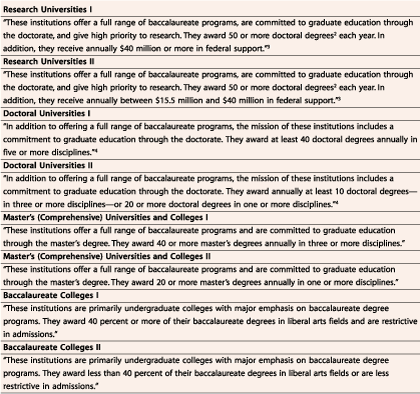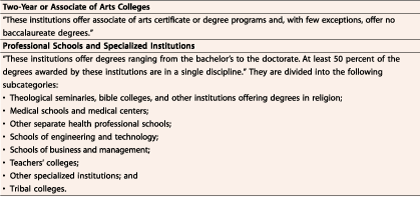

<< Go Back |
| Note 8: Classification of Postsecondary Education Institutions |
|
The U.S. Department of Education's Integrated Postsecondary Education Data System (IPEDS) employs various categories to classify postsecondary institutions. This note outlines the different categories used in varying combinations in indicators 5, 7, 19, 20, 21, 23, 32, 33, 34, 35, 42, and 43. BASIC IPEDS CLASSIFICATIONS The term "postsecondary institutions" is the category used to refer to institutions with formal instructional programs and a curriculum designed primarily for students who have completed the requirements for a high school diploma or its equivalent. For many analyses, however, comparing all institutions from across this broad universe of postsecondary institutions would not be appropriate. Thus, postsecondary institutions are placed in one of three levels, based on the highest award offered at the institution:
Postsecondary institutions are further divided according to these criteria: degree-granting versus nondegree-granting; type of financial control; and Title IV-participating versus not Title IV-participating. Degree-granting institutions offer associate's, bachelor's, master's, doctor's, and/or first-professional degrees that a state agency recognizes or authorizes. Nondegree-granting institutions offer other kinds of credentials and exist at all three levels. The number of 4-year nondegree-granting institutions is small compared with the number at both the 2-year but less-than-4-year and less-than-2-year levels. IPEDS classifies institutions at each of the three levels of institutions by type of financial control: public; private not-for-profit; or private for-profit (e.g., proprietary schools). Thus, IPEDS divides the universe of postsecondary institutions into nine different "sectors." In some sectors (for example, 4-year private for-profit institutions), the number of institutions is small relative to other sectors. Institutions in any of these sectors can be degree- or nondegree-granting. Institutions in any of these sectors can also be Title IV-participating or not. For an institution to participate in federal Title IV, Part C, financial aid programs, it must offer a program of study at least 300-clock hours in length; have accreditation recognized by the U.S. Department of Education; have been in business for at least 2 years; and have a Title IV participation agreement with the U.S. Department of Education.
CARNEGIE CLASSIFICATION The Carnegie Classification groups American colleges and universities by their purpose and size. First developed in 1970 by the Carnegie Commission on Higher Education, the classification system does not establish a hierarchy among 2- and 4-year degree-granting institutions; instead it groups colleges and universities with similar programs and purposes to facilitate meaningful comparisons and analysis. The Carnegie Classification system has been revised four times—in 1976, 1987, 1994, and 2000—since it was created. The 1994 classification, used for indicators in this volume, divides institutions of higher education into 10 categories, with the 10th category—Professional Schools and Specialized Institutions—subdivided into 10 subcategories (see table of definitions on next page). The information used to classify institutions into the Carnegie categories comes from survey data. The 1994 version of Carnegie Classifications relied on data from IPEDS, the National Science Foundation, The College Board, and the 1994 Higher Education Directory published by Higher Education Publications, Inc. For the purposes of analysis, indicators 20, 32, 35, and 43 use the Carnegie Classifications (reprinted below) to subdivide the IPEDS groupings (e.g., 4-year institutions—an IPEDS grouping—may be subdivided into research, doctoral, master's, and/or other institutions, which are Carnegie Classifications). The following key provides a guide to each indicator's category labels and what Carnegie Classification categories they include. Indicator 20
Indicator 32 includes the same four categories as indicator 20 plus
Indicator 35
Indicator 43
|
Carnegie Classification Categories (1994 Definitions1)  |
|
Carnegie Classification Categories (1994 Definitions1)—Continued  1Carnegie Foundation for the Advancement of Teaching (1994). In December 2000, the Carnegie Foundation released an updated version of its classification system of institutions of higher education. The new scheme is available at the Carnegie foundation website (http://www.carnegiefoundation.org/Classification/index.htm). 2Doctoral degrees include Doctor of Education, Doctor of Juridical Science, Doctor of Public Health, and the Ph.D. in any field. 3Total federal obligation figures are available from the National Science Foundation's annual report, Federal Support to Universities, Colleges, and Nonprofit Institutions. The years used in averaging total federal obligations are 1989, 1990, and 1991. 4The academic year for determining the number of degrees awarded by institutions was 1983–84. |
|
|